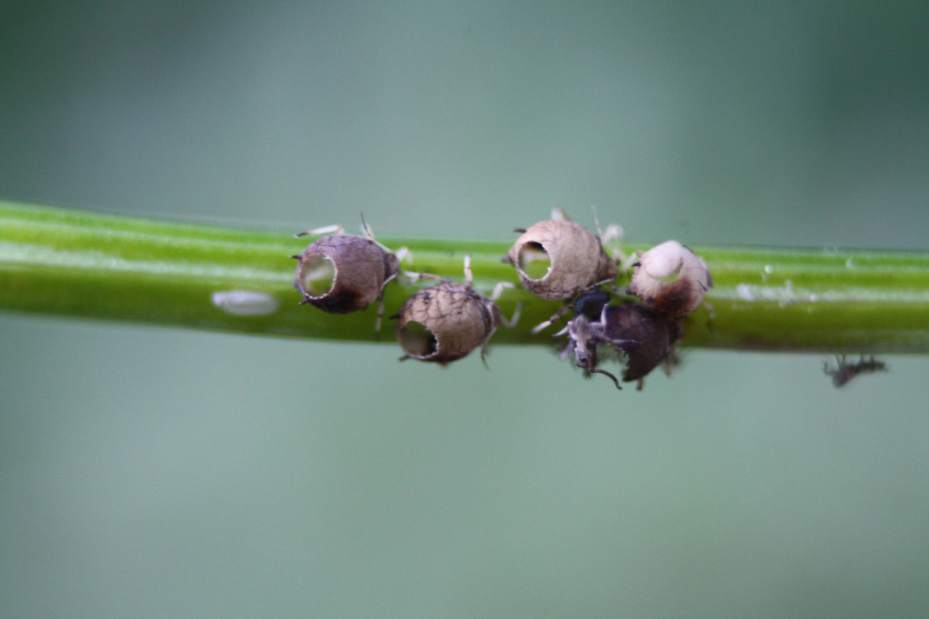Parasitic wasps nasty but needed
I'd like to tell you about an interesting group of insects that plays an important and beneficial role in our yards and gardens: the parasitic wasps.
They aren't the kind of wasps that build those big, papery nests. Nor are they the kind that sting you (most don't have stingers).
This highly specialized group of wasps helps control hundreds of pest insect species in our gardens by parasitizing them.
There are thousands of species of parasitic wasps across North America, and all have co-evolved with the insects they parasitize. They are one of nature's most amazing control systems — keeping many pest-insect populations in check.
Parasitic wasps can be as small as a gnat or as long as your pinky finger. Nearly all of them use other insects as hosts for their developing young, with many of them being host specific and utilizing only one or two species of insects for this task.
Most often, female parasitic wasps lay eggs singly or in groups inside of the host insect. The larvae then hatch and develop inside of the host, consuming the non-vital tissues first to ensure the host survives until the larvae are ready to pupate into adults.
Parasitic wasps attack almost every group of insects, including aphids, beetles, flies, scales, true bugs and caterpillars of every sort.
What may look like a nasty stinger protruding from the abdomen of female parasitic wasps is actually an ovipositor. Different parasitic wasps have different egg-laying equipment. Depending on who is being parasitized, the ovipositor can be short and spiky, long and wispy, or somewhere in between.
Here are a few commonly encountered parasitic wasps to be on the look out for:
Braconid wasps: Members of this group average 1⁄16-inch long. Many of them resemble small, black flies with pinched “waists.” Within this family are many species in the genus Cotesia. These wasps use caterpillars to feed their young, and gardeners can often find their white, rice-like cocoons clinging to tomato and tobacco hornworms in the summer.
Different Cotesia species also parasitize cabbageworms, cutworms, corn earworms, gypsy moths, tobacco budworms and other caterpillars. When the larvae have matured inside their host, they chew small holes through the skin of the caterpillar and spin external cocoons in which they pupate for four to six days. Once mature, the adult wasps “pop the top” off the cocoon and fly off.
Aphidius wasps: This group uses only aphids as larval hosts. Most measure a mere 0.1 inch — certainly, small enough to maneuver their way around a colony of tiny aphids. They are incredibly common and spotting evidence of these wasps is as easy as reaching for a magnifying glass.
These wasps attack their aphid hosts by laying a single egg in each aphid. The larva hatches soon after and excavates the aphid, leaving a swollen brown exoskeleton behind (commonly called an aphid “mummy”).
Ichneumonid wasps: Most species are large (up to 1.5 inches) and slender with long antennae. Many females have a highly noticeable ovipositor; it is sometimes longer than the insect's body. Ichneumon wasps can be yellow to black or have patterns of various colors. They use caterpillars, the wood-boring grubs of various beetles, and other insects as hosts. I find a few of them flying around my garden looking for host insects every year.
Horticulturist Jessica Walliser co-hosts “The Organic Gardeners” at 7 a.m. Sundays on KDKA Radio. She is the author of several gardening books, including “Attracting Beneficial Bugs to Your Garden: A Natural Approach to Pest Control” and “Good Bug, Bad Bug.” Her website is www.jessicawalliser.com.
Send your gardening or landscaping questions to tribliving@tribweb.com or The Good Earth, 503 Martindale St., 3rd Floor, D.L. Clark Building, Pittsburgh, PA 15212.

